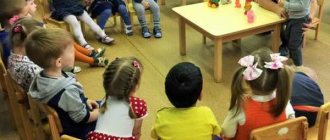Abstract on the topic Self-service in the middle group
Summary of lessons on organizing self-service for the middle group
Purpose: - to teach children to maintain order in the playroom, bedroom, locker room; promptly and immediately put each thing in its place, help adults and peers in cotton work.
-develop skills independently and with the help of adults and peers, maintain and restore order in the group
- to cultivate diligence, respect for working people: the ability and desire to value one’s own and other people’s work.
Equipment: household items and object pictures, Brownie toy.
Progress of the lesson
The day before, the teacher reads L. Voronkova’s story “Masha the Confused” to the children and conducts a conversation on its content:
-Who is the story about? Who woke up Masha in the d/s?
-Why was Masha late to the nursery one day?
</ -Почему она не смогла найти свои вещи сразу? Где лежали чулки? Где она нашла туфли? Куда было заброшено платье? Где она встретила детей в д/с? Кто виноват, что Маша опоздала?
Educator: -Who keeps order in the house?
- How do you help your mother with this?
-Who keeps order in the group?
-Do you help adults with this? How?
Children: we put toys away, hang clothes in a locker, put them on a high chair before going to bed, put shoes on a shelf, set the table, remove glasses from the table after eating.
Educator: Well done, everyone is attentive and helps maintain order in the group.
We will now go on a tour of the group and see if all the things are in place. If someone does not put the toy back in its place, then the toys may become offended and hide from you.
Teacher: approaches the sports corner and asks the children to name what is missing.
Children: skittles and ball.
Educator: approaches the music corner with the children and asks them to name what is missing?
Children: baskets with rattles
- in the arts and crafts corner - coloring books.
Educator: you see, the children hid a lot of things. But I’ll tell you who can help find them.
You know this hero. This is Brownie, he lives in every house and knows everything that happens in it. The teacher shows the children Brownie and pays attention to his appearance, and says that he is kind, attentive, caring and in his hands he has a bag in which there may be missing toys.
Brownie wants to play with you D/n.
"Wonderful bag"
The teacher calls one child at a time and asks them to take any item out of the bag. The child takes out the object, names it and takes it to its place. After the game, the teacher talks with the children:
-Why should every thing be in its place?
Children: so as not to waste time looking for it and you can take it right away.
Educator: who should keep order?
Children: adults and children.
Educator: you know where each of the things should be. But in every group and home there are many small items and they should also have their place. Brownie offers to play d/i “Every thing has its place”
There are a lot of small items on the table (sewing supplies, pencils, ribbons, hairpins, elastic bands, decorations for dolls) and (boxes, boxes, baskets, cups).
The teacher with the Little Brownie asks one of the called children to find a place for each item. After the game, Brownie rewards the children with stars for their help.
Methodology for developing self-service skills. Average age
.Free quota operation: how to get it and what’s changing in 2019 |
How to do IVF for free under compulsory medical insurance: what documents are needed
Detsky sad.Ru >> Electronic library >> Family and children >> Labor education >> “Educating a preschooler at work.” Ed. V. G. Nechaeva Publishing house "Prosveshcheniye", M., 1974 OCR Detskiysad.Ru Given with some abbreviations
In the middle group (children of the fifth year of life), in addition to consolidating previously acquired skills, work is carried out to develop more complex skills in children self-care skills.
Children in the middle group can show greater independence in washing, dressing, and eating. These tasks remain the main ones at this age level. In practice, there are many five-year-old children who, thanks to systematic exercise, are accustomed to personal hygiene, neatness and order. Here is the typical behavior of a five-year-old child when washing his face towards the end of his stay in the middle group. Tolya quickly went to the washbasin, energetically rolled up the sleeves of his shirt, and wet his hands with water. Then he took the soap, lathered them generously up to the elbows, and rinsed them off with water. In order to make sure how well he washed them, he made vigorous circular movements with his hands, listened to whether they “creaked,” then washed his face and went to dry himself with a towel. Since children have mastered many basic self-care skills by age five, they are tasked with helping each other get dressed. It is everyday and can be implemented whenever the child himself cannot cope with it: tie a scarf at the back, fasten the buttons at the back of a dress, untie a knot of ribbon. What children could do for themselves is considered reprehensible to do for them. Observations of children's behavior are interesting in this regard. Vitalik couldn’t fasten the buttons on his coat for a long time; he did it diligently, but every time the buttons were torn out of his hands the moment the edges fell into the loop. Sveta offered to help Vitalik button up his coat. Vitalik readily agreed, but then unbuttoned all the buttons and began to button them again. When asked why he unbuttoned his coat, Vitalik said: “I did it myself, I know how to do it now.” Some children, after wearing felt boots (in the spring), find it difficult to lace and tie their boots, put them on and fasten them. For many children, this is a new skill to learn. Educators must patiently teach them how to do this and ensure that they cope with this task themselves. As observations show, girls master this skill faster. The exercises that they constantly do while playing with dolls - fastening buttons and hooks, lacing, tying - contribute to the development of their small arm muscles, so it is easier for them than boys to cope with these actions. Girls readily help those who cannot cope. The role of the educator is to lead this process. It is necessary that children who do not know how to tie their shoes should be taught to tie their shoes by children who already know how to do it. They willingly teach their comrades and jealously monitor their progress. “And today Gena already laced his shoes himself, he just doesn’t know how to tie a bow,” Valya told the teacher. Sasha took the longest to cope with this task. The children gave him advice in advance on how best to do this. “First put the shoe on well, then take the laces, one in one hole and the other in the other, so that they go evenly,” Sveta said. Sasha’s sister, Olya, was angry with her brother: “He knows everything how to do it, but he doesn’t want to, because his mother does everything for him at home.” Organizing communication between five-year-olds and third-year children makes it possible for them to be the first to practice helping with getting dressed and putting away toys (while reminding them where they are stored). This assistance activity is especially successful if children are taught to obey older children. The teacher develops the ability to provide assistance in self-care in all children, without exception. Timid, indecisive children become more active in the conditions of assistance, striving to show their skills and accuracy of performance. The formation of the ability to provide assistance to peers and younger children is carried out as a result of the active interaction of children with each other in the process of dressing, undressing, eating, and washing. The teacher gives, for example, the following tasks: help take off a shirt, turn out the sleeves, tell me how to properly hang laundry on a chair, clothes in a closet, how to use a fork, etc. These and similar tasks create a variety of situations in which children can save money. experience of independent behavior in everyday processes, acquire the qualities necessary in everyday life, and form a sufficiently high level of independence in all children. Involving five-year-olds in helping young children is successful only if the former know in advance in what form this help can be provided and master these skills. If a child, for example, does not know how to fasten his own shoe, he will not be able to do it for another. Thus, the key to successfully involving a child as an assistant to another is the presence of a fixed skill in fulfilling the well-known rule of self-service. A child whose actions have been consolidated and whose skills have been developed, with great desire and interest, agrees to come to the aid of another. At the same time, practice shows that children, even having the skills of dressing and undressing, sometimes cannot apply the learned method of action in relation to their peers. Children begin to get lost, feel insecure, and turn to the teacher for help. This is explained by the fact that the children were not taught how to transfer their skills to other conditions and situations. Therefore, the teacher’s task at first, when involving children in providing assistance, is to remind (and perhaps show and explain) what needs to be done and how. This instills in them confidence in their abilities and convinces them of their skills. Around the second half of the year, the teacher increasingly limits himself to general reminders: “Do everything the way you do it for yourself, so that it is neat, correct, beautiful.” Systematic work to include children in helping each other has a positive impact on the development of the ability to come to the rescue without the constantly repeating demands of the teacher, independently. By the end of the fifth year of life, children not only strive to fulfill the adult’s task of helping someone, but also try to “teach” the person under their care how and what actions need to be performed. The form of assistance is becoming more advanced: in addition to direct practical actions, elements of training are increasingly appearing. There is active verbal communication between the “helper” and the “ward”. Here's a typical example. Slava received the task of helping the kids who came from a walk undress. The boy immediately turns to the baby and says: “Where is your closet? Let me help you undress.” The baby doesn't listen. “You can’t play around,” Slava continues and persistently begins to untie the scarf. The baby resists at first, then calms down. “Where is your closet?” - Slava repeats. “Tutla,” the kid answers and points to the closet where the doll is painted. “Not a tutla, but a doll. Say: "Doll." Now hang up your scarf. Do you know where the scarf hangs? Do not you know? It needs to be hung on a nail.” Slava hangs the scarf himself. The baby looks attentively, etc. It is good when the interaction of children of different ages is accompanied by the manifestation of good feelings: sympathy, sympathy and tenderness, care. However, undesirable manifestations can sometimes be observed in the behavior of five-year-old children. For example, when communicating with children, they begin to command them too much, take care of them, and do not allow them to perform any actions themselves. The teacher manages to avoid this if he first specially prepares children for working with young children. It’s good if he talks to them about how and what exactly they need to help the little ones with, what they can be taught, and what they can be given the opportunity to show independence in. The teacher achieves from five-year-olds almost complete independence in self-care. After all, the skills they acquired at 3-4 years of age have become more durable and conscious. When strengthening self-service skills in children, the teacher increasingly turns to their consciousness. He points out to children the permanent responsibilities in this type of work, explains why they need to be fulfilled, and shows their importance to others. Sometimes in children by the age of 5 one can observe a decrease in interest in self-care work. This is caused by the simplicity and monotony of actions, frequent repetition of activities (dressing, putting away toys, eating, etc.), as well as the child’s insufficiently developed skills of independence, neatness and cleanliness at the previous stage. Therefore, it is necessary to pay more attention to children’s self-care exercises; to interest them in the diversity of this work, to create a certain emotional atmosphere. Thus, the condition for consolidating self-service skills, turning them into habits, and at the same time the condition for developing independence in everyday activities is maintaining interest in it. This is facilitated by the emotional experiences that the child experiences when undressing and dressing. That is why, at this age level, encouragement and objective assessment of his activities are so necessary. The emergence of a positive emotional state in self-service activities is also facilitated if the teacher brings to the awareness of children what is good in their behavior, emphasizing the importance of independent activity for others and for the group of children as a whole. The teacher says: “Look how quickly Vanya and Sasha got dressed today. Sveta and Sonya helped them. Now let’s all play together.” Analysis of labor results and their objective assessment become an effective method of raising children if the teacher strives to strengthen their desire to perform their duties better, faster, and on time. The adult gradually teaches the children to evaluate their own achievements in self-service and correct shortcomings on their own initiative. The whole atmosphere of life in a peer group helps to develop self-esteem in children of the average group. If one of the children has an incorrect attitude towards his duties (he didn’t make the bed well, didn’t get dressed for a long time, and delayed the children for a music lesson), the teacher, together with his friends, condemns him. As before, children in the middle group imitate their elders in performing self-care work, but they do it more consciously. The teacher becomes an authority for the children. They exactly repeat his actions, imitate even in small things. It is important that children feel in the tone of adults the obligation to fulfill their demands. At this age, you can already demand much more from children than from little ones. continuation of the book...




